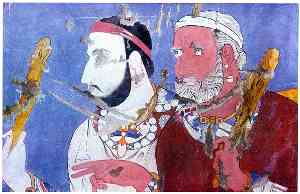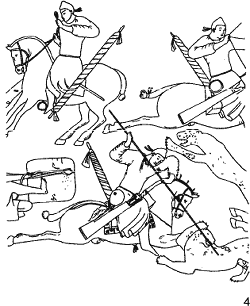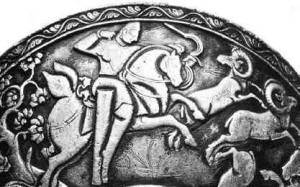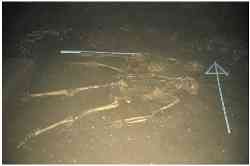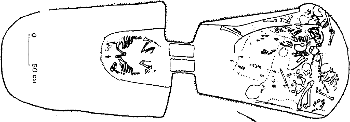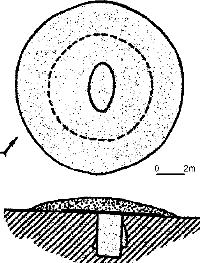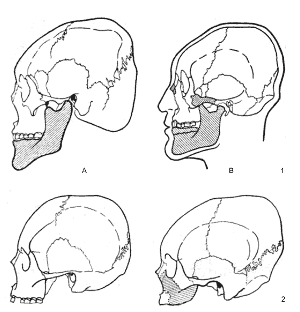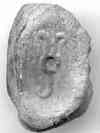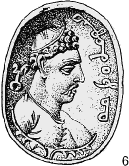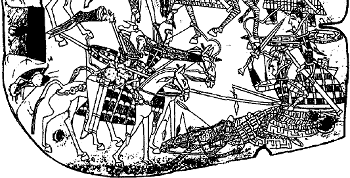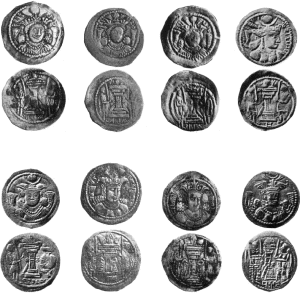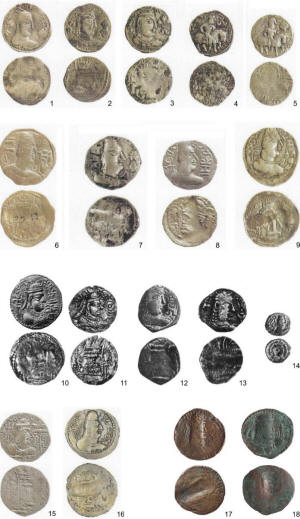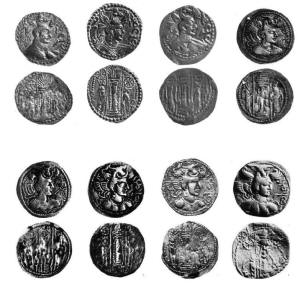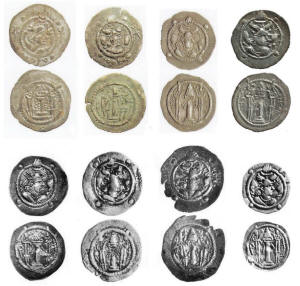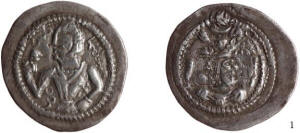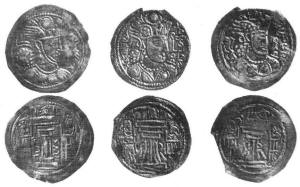| Ephthalite White Huns (Hephthalites) |
||||||||||||||||||||||||||||||||||||||||||||
 |
Aidogdy Kurbanov THE HEPHTHALITES: ARCHAEOLOGICAL AND HISTORICAL ANALYSIS PhD thesis, Free University, Berlin, 2010, © |
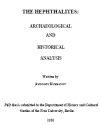 |
||||||||||||||||||||||||||||||||||||||||||
|
Links |
||||||||||||||||||||||||||||||||||||||||||||
|
http://www.diss.fu-berlin.de/diss/receive/FUDISS_thesis_000000016150 |
||||||||||||||||||||||||||||||||||||||||||||
|
Foreword |
||||||||||||||||||||||||||||||||||||||||||||
|
This posting presents two chapters of the PhD dissertation, on historiography and modern demography. A complete text, with many details and illustrations, is located at the link above. Actually, all basic facts needed to reconstruct the history of Ephthalites were around for better then half a century. Ever since N.V.Pigulevskaya laid out the ethnic situation, and S.P.Tolsov's group published results and assessments of their archeological, anthropological, numismatic, and topographical studies, the puzzle created by numerous written records was mostly resolved, only few material details were added afterwards. However, the flood of most weird fantastical speculations did not abate, driven predominantly by the parochial interests of patriotic scientists. The general picture, already drawn in the Late Antiquity time, but clouded by an exceeding mass of foggy depictions, present a scenario played over and over again in the lands abutting the Eurasian steppes. Major chunks of the Eastern Huns, injured in their home locations, moved over to safer and better pastures, carrying their dynasties first to their possessions in the Middle Asia, and then on to the Caucasus, to Volga-Ural, to Europe, to South Middle Asia, to the Middle East. In every place on the way they reconstituted their power and their state, reorganized local population to accommodate a new situation, and in a couple generations renewed their expansion. At every turn of the history, they acquired new languages, new customs, new culture, and new slate of the rulers. At every turn of the history, they also introduced their language, their customs, their culture, and in many cases their dynasties. In most of the Europe, Caucasus, and Middle East the modern “national“ histories eradicated that portion of their past, but in the South Middle Asia their past became an integral part and a pride of their history. Johals in India and Pakistan, Gujars and Rajputs in India value their descendency from the Hepthalites, and take pride in their individual and collective history. Many others, like the Abdaly of Russia, Turkmenistan, Kazakhstan etc., Karluks and Kalaches of Russia, Iran, etc., were suckled on sanitized versions of their national histories, just gained access to uncensored information available on the Web, and for the first time are learning about their own past from the sources outside of the manipulations of their national controls, while the children in their countries are still being fed deceptive woodoo truths. In a nutshell, the Eastern Huns and their allied subjects moved into the western Middle Asia in waves starting with the debacle of the Kagan Jiji in 36 BC near the modern Taraz, and continuing with every new disaster, until the battle with Jujans at river Yili in 410 AD, when a part of the Huns accepted Jujan rule, and the rest escaped away from the Jujan control. Some of the refugees re-established their center in the northern Horesm, and started their expansion from there, moving into Badakhshan, Tokharistan, and the territories of modern Afganistan, Pakistan, and India. The bulk of the manpower, naturally, consisted of the local tribes, a most important of which were Masguts, a blend of the N.Pontic and Central Asian Türkic tribes with Sogdians. Archeologically, the aristocratic burials predominate because of their better visibility, and consequently osteological materials tend to show greater Mongoloidness and more cranial deformation then saw in the newcomers their contemporaries. Once settled in the new territories, the new rulers intermixed with the remaining local population, the rulers entered into new marital relations with the local chieftains, grew acculturated to the local languages and cultures, and defended their new domain until they were defeated and dismembered by a joint venture of the Sasanid Persia and Eastern Huns' heirs Ashina Türks in 552 AD. The Ephthalite empire lasted for about 130 years, about 6-7 generations, long enough to accumulate a considerable history, but not long enough to lose its own language, culture, and ethnic distinction. We still are not able to create a consistent history of the people and states that played a major role in the Eurasian history, the War people, who appear in the records as Var/Uar/Aor/Aorses, Warhonites/Varhonites, Awars/Avars, Jujans/Jou-jans/Juan Juans/Rourans/Ruanruans, and other variations. The treatment of the Jujans as a solid monoethnic community is counterproductive, since it ascribes a single set of traits to a conglomerate where the dominant Juan tribe was a vanishingly tiny minority, and even that could be a political union, as suggested L.Gumilev. Page numbers are shown in blue at the beginning of the page. Posting Notes are in (blue italics and parentheses), or are in blue boxes. Terms with diacritics are dubbed in standard font in parentheses. Some direct citations of other authors indiscriminately use the Türkic word “ordu“, army (Engl. “Horde“) for the whole population of a tribe, a group of clans, or for a single clan, and also as a synonym for “they“ vs “us“, as a faceless crowd; this term is elucidated with a suitable semantical clarification. The term Iran, Iranian pertains to the modern country of Iran, and to the linguistic classification or attribution respectively, while the term Persia, Persian refers to the country of Persia until 1934, and the language of Persia; the Persian language is one of the Iranian languages, and any reference to an Iranian origin or group alludes only to its linguistic affiliation. |
||||||||||||||||||||||||||||||||||||||||||||
|
Illustrations cited in the A.Kurbanov work |
||||||||||||||||||||||||||||||||||||||||||||
|
||||||||||||||||||||||||||||||||||||||||||||
|
Aidogdy Kurbanov Hephthalites |
||||||||||||||||||||||||||||||||||||||||||||
|
2
2.1. Research History (abstract) In the absence of authentic evidence, the coins issued by the Hephthalite leaders constitute one of most reliable primary sources for the history of the Hephthalites. It must be emphasized that our knowledge of these Central Asian nomads is, to a certain extent, still vague; and the research on their history remains controversial. All above named medieval sources have served as the main base for multiple judgments on the ethnic history of the Hephthalites. Some researchers see in Hephthalites descendants of Yuezhi (Tochars) (V. de Saint-Martin, V. Bartold, N. Veselovsky, G. Grum-Grzhimailo), 2 others derive them from ancient Mongols (J. Marquart, R. Grousset) 3 or Huns assimilated by Central Asian people (S. Tolstov, A. Bernshtam). 4 Yet another theory considers an Iranian language of the Hephthalites and their Iranian origin (A. Mandelshtam, M. Dyakonov, B. Gafurov). 5 Bartold, K. Enoki, L. Gumilev and Gafurov 6 think the Hephthalites were quite different peoples than the Chionites; others (R. Girshman, Tolstov, Bernshtam, Mandelshtam, V. Masson) 7 try to prove their identity or consider that the Hephthalites were the name of the dominating class of the Chionites. 2 Saint-Martin 1849; Bartold (Áàðòîëüä) 1963; Veselovsky (Âåñåëîâñêèé) 1877; Grum-Grjimailo (Ãðóì-Ãðæèìàéëî) 1926. Various authors listed above are only more prominent authors who grappled with the question of who were the Hephthalites. Many others argued that Hephthalites were Mongols, or Türks, or Huns, or a number of other ethnicities. That shows how fragmentary and confused the historical sources are, and that they must be combined with other lines of evidence in order to understand Hephthalite history. For the first time in European historiography the Hephthalites were mentioned in the “Bibliotheque Orientale“ of D'Herbelot in 1697, under the name Haietelah and then in the work of Assemani (“Bibliotheca Orientalis“) in 1719 as Haithal, where were given extracts from medieval Syrian sources. Later, J. Deguignes dedicated one of the chapters in his multivolume work “Histoire generale des Huns“, to the Hephthalites, where he explained their name from the Persian word ab (water) plus Tie-lé or Telite (according to Deguignes one of the names of the Huns who moved to Transoxiana) - Abtelite (water Huns) because they had a residency near the Amudarya river.8 V. de Saint-Martin (1802-1897) was among the first to suppose that the Hephthalites were descendants of the Yuezhi (Tokhars) and had a Tibetan origin. 9 Ed. Specht and E. Parker, who think that they were different tribes, argued against that theory. 10 Gumilev also gives a number of arguments against Saint-Martin theory. First, Gumilev notes that the version of identity between the Yuezhi (Tokhars) and the Hephthalites is unconvincing, because the “Beishi“, along with Yeda also referred to Da Yuezhi (Greater Tokhars). Secondly, the author of the “Suishu“ mentions only the ruling dynasty of the Hephthalites from the Yuezhi (Tokhars), but not all the people. Thus, according to Gumilev, Saint-Martin's hypothesis is unproven. 11
7 Girshman 1948; Tolstov (Òîëñòîâ) 1948a;
Tolstov (Òîëñòîâ) 1948b; Tolstov (Òîëñòîâ) 1962; Bernstam (Áåðíøòàì) 1947b; Bernstam
(Áåðíøòàì) 1951a; Mandelshtam (Ìàíäåëüøòàì) 1958a;
Mandelshtam (Ìàíäåëüøòàì) 1958b; (Masson) Ìàññîí 1964. He put forward his own hypothesis, suggesting that the Kidarites, Chionites and Hephthalites were different peoples: the Kidarites were Yuezhi (Tokhars); the Chionites (or Huni) were residents of “Marsh sites “from the northern shore of the Aral Sea, and were descendants of the Saka tribe “Huaona“ (i.e. Huns); the Hephthalites were mountain people, tribal descendants of light-haired Baidi people, who in the 7th century BC came from the northwestern China to the mountainous area of the Pamir and Hindukush. For eight hundred years, Baidi might have mixed with the local Aryan tribes of Indo-Iranian group and in the Kushan time (1st - 2nd centuries AD), one of the branches of the tribe Hua, settled in the valley Eftal, received a new name “Hephthalites“ (Greek) or “Yeda“ (Chinese) from the name of the valley or perhaps on behalf of the first leader. At the end of 4th c. AD the Hephthalites were already an organized tribe, and at the beginning of the 5th c. AD their state claimed hegemony in Central Asia and India. This expansion, according to Gumilev, occurred through a union of all the mountain tribes of the Pamir and the Hindukush, which involved the expansion of the concept Eftal. Thus, according to the hypotheses of Gumilev, the Hephthalites were the people of the mountainous areas of the Pamir and the Hindukush. 12 Before Gumilev, Enoki had come to a similar opinion by exploring Chinese sources. After his analysis, he indicated that Chinese authors had only approximate knowledge of the origin of the Hephthalites. Enoki agrees with Girshman that Hephthalites were speaking Iranian language, but he distinguishes them from the Chionites, who, in his opinion, were Huns. The Chionite kingdom in Sogd was conquered by Hephthalites under a royal family Jauvla or Chao-wu (aka Johal, Jouhal, Joval, Jauvla, Jauhal, Jauhla, Jatt, Jat). Enoki based his theory on the information from Chinese chronicle “Suishu“ which recorded that royal family of Sogd was earlier known as Wen (Huns - per Enoki) and later as Chao-wu. 13 Enoki suggests that the Hephthalite Empire had two centers in the Upper Amudarya area. 12 Gumilev (Ãóìèëåâ) 1959, 140. One center was in western Badakhshan (northeastern Afghanistan and southeastern Tajikistan) and is identical to the country Hsi-mo-ta-lo in Xuanzang's description of the western countries. This name, which means “foot of the snow mountain“ can be a Sanskritized form of the ethnonym Hephthalites.14 It would be situated high in Tokharistan, and would be isolated. The Hephthalites lived in isolation form others and practiced polyandry. Another center was in Ghur (south of Kunduz), and that is the Hua of the Chinese sources, and Gorgo of Procopius. According to Enoki, this argument also supports a theory that an origin of the Hephthalites was eastern Tokharistan on the upper Amudarya, or in the Hindukush mountains, and therefore it could explain why the Hephthalites did not establish their center near the Altai mountains, as noted in the Chinese sources as their place of origin. 15 Another argument for the local origin of the Hephthalites is that Sogd was conquered almost 20 years after (ca 440) Hephthalites had settled in Tokharistan and north-western India (ca 420). On the base of an analysis of the “Weishu“ embassies sent from Sogd (Su-te), Enoki suggests that Sogd was conquered by the Hephthalites between AD 467-473 and 480, because the last recorded embassy from Sogd (to China) occurred in AD 479.16 According to the Chinese sources, the Hephthalites established their state 80 or 90 years prior to the reign of the emperor Wen-ch'eng (452-465). The first embassy of the Hephthalites to China was in AD 456, and calculating back from this date, the founding of their state would fall on AD 366 or 376. Enoki does not agree with these dates and he thought that it was impossible for the Hephthalites to start extending their power in the middle of the 4th c. AD and establish their state between 437 and 456. 17 The Hephthalites sent a second embassy to Northern (Toba) Wei in AD 507, fifty years after the first one. From AD 507 to 531, they dispatched 13 embassies to the same court. The Hephthalites conquered Gandhara between AD 477 and 520. In AD 477, the Kidarites in Gandhara sent a last embassy to the court of Northern (Toba) Wei, and in AD 520 Song Yun saw Gandhara under Hephthalite control. 18 14 Enoki 1959, 35-36. The origin of polyandry, as has been indicated by E. Nerazik, is explained by the fact that the Hephthalites made ancient Bactria the center of their state and, according to numismatic data, considered themselves direct successors of the Kushans. Thereby, their rule was perceived as direct continuation of the Kushans. Starting from that idea, in the opinion of Nerazik, historical science follows to elaborate who was the first ruler in Hsi-mo-ta-lo and, in this tradition, can go back to traditions about the Yuezhi conquest. However, if this is so, then it is impossible to use it as proof of the Hephthalites' spread from Badakhshan (northeastern Afghanistan and southeastern Tajikistan).19 Having deciphered legends on the Hephthalite coins, Girshman came to a conclusion that their language belonged to the Eastern Iranian group (i.e Sogdian, Horezmian). He read an inscription as “Eptla Shaho Hio(no)“, which means - Hephtal king of Chions, and thus came to a conclusion that the Chionites and the Hephthalites were one folk; the Hephthalites were a name of the ruling class, but Chionites was the name of the common people (Generic Huns led by Tele tribe Abdaly). 20 Girshman writes that the Chionites were a population that appeared in the territory of Bactria already in the mid of the 4th c. AD. Several Chionite (Hun) kings carried a name “Heftal“ (Abdal, Ab-Tele), and their dynastic name was extended by the Chionites neighbors to the whole people. According to Girshman, the phonic similarity of the “Hion“ and “Hun“ explain why the Byzantine sources named these tribes “White Huns“. He suggested that Hephthalites came from Eastern Turkestan and conquered Bactria in AD 371. 21 Before they arrived in the territory of Central Asia, and consolidated south of the Oxus (Amudarya), the Chionites passed through Karashar, Kucha, Hotan and Kashgar. 22 The Kidarites, per Girshman, were the late Kushans: “fourth dynasty of Kushans“. 23 He also thought that the Hephthalites were a northern group of the Chionites, a branch of the Da Yuezhi (Greater Tokhars) and the Sakas. A southern branch were Zabulites, ruled by Mihirakula in AD 515-544. 19 Nezarik (Íåðàçèê) 1963, 554. The Hindukush separated the two groups and gave each a separate history. They were Persians, and Girshman is inclined to agree with al-Masudi, who stated that the Hephthalites were Sogdians who lived between Bukhara and Samarqand. 24 V. Livshits supported the Girshman theory, noting “the basic conclusion of Girshman that the Hephthalites were one of the branches of the Chionites and that the own name of the Hephthalites was “Hyon“ in Middle Persian sources (OIONO on the coins)“. But Livshits does not agree with the reconstruction of the Hephthalite dynasty's rulers, based on readings of coin legends which he believes raises serious doubt. 25 In fact, several scholars questioned the Girshman's reading of the Hephthalite coins. Some of them opposed the identity of the Chionites and Hephthalites. For example, V.Masson wrote: “The epigraphic reading of legends by R. Girshman is not justified“. M. Dyakonov and A. Mandelshtam suggested that the Girshman's reading of the Hephthalite coins legends “Represents only a working hypothesis that allowed a good agreemeny on many controversial signs, but did not remove all questions“. 27 In their opinion, the identity of the Chionites and the Hephthalites can not be proved, since the reading of the legends on the coins “raises many doubts“. 28 Nevertheless, one of these authors (Mandelshtam) in his other work wrote quite differently: “Girshman offered identification of the Chionites and Hephthalites, and that is reasonable from the reading of the legends on a large number of the Hephthalite coins“. 29 V. Masson considers the Hephthalites as coming from the Transsyrdarya steppes (i.e. Kazakhstan steppes?), regarding them as nomads speaking languages of the Iranian group (i.e. not Sogdian language). In one aspect V. Masson agrees with Girshman: that the Chionites and Hephthalites were one people. 24 Girshman 1948, 104, 119; Scaglia 1958, 25. According to V. Masson, the Kidarites were Kushans. Kidara was one of the small Kushan rulers, he conquered Bactria from the Sasanids, creating his own state, which in the historical literature is sometimes called a Lesser Kushan state. 30 H. Bailey suggests that in the Pehlevi texts, in particular in the “Jamasp-name“, is information about fighting between Persia and the “White Khyōn (Khyon)“, and that the “Zand-i Vohuman Yasn“ (The Pehlevi Zandi Vohuman Yasht) (“Interpretation Vohuman Yasn“ Bakhman Yasht) reported a defeat of the Sasanids: “Kingdom and Sovereignty will pass to slaves who are not Iranians, such as Khyōn (Khyon), Türk, Heftal, and Tibetans, who are among mountain-dwellers, and the Chinese, and Kabūlis, and Sogdians, and Byzantines, and Red Khyōn (Khyon) and White Khyōn (Khyon). They will become Kings in my country of Eran. Their commandments and desires will prevail in the world“. 31 Regarding the Red Khyōn (Khyon), the commentator of the “Bakhman-Yasht“ stated that their name is linked to their red hats, red armour and red banners. In the Indian sources, especially in the text of Varahamihira, there is reference to the Sveta Huna and Hara (Hala) Huna. Hara Huna is identified with Red Hiona, i.e. with the people whose name is deciphered, as red-caped, mentioned in a poem in the Khotan-Saka language of the 7th c. AD. 32 As we see in the texts appear Hions (Khyōn), Hephthalites (Heftal) and the so-called Red Hions (Khyōn) and White Hions (Khyōn). The list of people called as the same ethnic group with different ethnonyms can be explained by mistakes. Such cases were not uncommon. Thus, in particular, the “Chronicle“ of Zacharias Rhetor (5th - 6th c. AD), the list of peoples leading nomadic life has both Abdels and Hephthalites. 33 According to P. Pelliot and S. Levi, the word “Hara“ in translation from Türkic means “black“. 34 30 Masson (Ìàññîí) 1964, 168. We may also note that among the Khazars a separation into “White“ and “Black“ also existed. 35 F. Grenet proposes that there are “good reasons to take αλχοννο as originally designating a people or a confederation, just as later on the Hephthalites put their abridged name ηβ on Bactrian coins imitating those of Peroz ... one may perhaps add the “Red Huns“ (Middle Persian Karmīr Hyōn), bearing in mind that āl means “red“ in Türkic (i..e. “Al-Honno“ stands for “Red Huns“). If the possibility that some of these Huns spoke an Altaic language may be entertained, such a derivation of Hala-/Hāra would appear more likely than that from Türkic qara “black“, as there is no other reference to “Black Huns“ in this historical context“.36 The “Bahman-Yasht“ makes a clear distinction between the Huns - both Red and White - and the Hephthalites, a distinction which is perpetuated by the Bactrian coin legends αλχανο and ηβ, the latter being an abbreviation of ηβοδαλο (ēvdal). 37 Attention is drawn to another point in Byzantine sources: except for references to the White Huns there is also information about Κερμιχίωνες (Kermihions). In particular, Theophannes the Byzantine said that east of Tanais there are Turks, who in ancient times were called Massagets, and in the Persian language are called Kermihions. According to Bailey, they are the same people who Pehlevi sources know as Karmir Hion. Ed. Chavannes saw in the Kermihions the Rourans or Ruanruans (in Chinese Wade-Giles - Jou-jan or Juan Juan - A.K. aka Jujans). 38 His version is close to the view of J. Marquart that Kermihion consists of two words: Kerm - worm and Hion - name of the Rourans (Jujans), known in the east in the 5th - 6th centuries. 39 35 Sinor 1994, 301. The Chinese contemptuously called these people Rourans (Jujans), which is the name of an insect, but perhaps this name remained in the west in the Iranian form Kerm + Ηίοη. 40. Μ. Artamonov thought that under the name “Kermihions“ for Chionites we should see: “worms-Chionites“. 41 O. Maenchen-Helfen thinks that ethnic name Hara-huna of the Indian inscriptions proves that at least those Hephthalites who invaded northwestern India were Iranian-lingual. Iranian hara - “red“ or “dark“ corresponds to kearmir “red“ in the Zoroastrian Pahlavi (karmir hyoan) and to kerm - in the Greek Kermihions. Hara-huna is not the name which the Indians gave to the invaders. It was their own name. They spoke an Iranian language. Possibly Heptal may contain Iranian hapta and mean “seven“. In the Ossetic language avd means “seven“ 42. On the wall paintings (south wall) in Afrasiab (Samarqand) (fig. 45) are depicted figures of two ambassadors, differing by color of their faces - red-faced and pale. Livshits suggested that the images are associated with White and Red Hions. 43 This idea is supported by some other authors as well. 44 But L. Albaum notes that the faces on the images of other ambassadors on the other three walls have different colors as well. 45
Mandelshtam and Dyakonov thought that the division of the Chionites into the Red and the White was associated with dividing them into two “wings“, which is typical for many nomadic tribes in both early as well as more recent periods. 46 Furthermore, these authors believe that the Chionites and the Hephthalites should be distinguished from each other; the Kidarites were Kushans, the Chionites were Iranian speaking nomadic tribes, the Hephthalites were also nomadic tribes, and the language of the legends of coins and documents of the Hephthalite time, found in eastern Turkestan, with known names of kings and rulers, suggest with considerable certainty that the Hephthalites were Iranian speaking people. 47 40 Bernstam (Áåðíøòàì) 1951a, 171. They also consider that the Kidarites and the Hephthalites had such a name due to their own generic or personal names of the kings and leaders, and played a greater role in the events of that time. According to E. Zeimal, there were two groups of tribes: the Kidarites and the Hephthalites. The Kidarites were a group that were named in the sources as the Chionites, Hunas, Da Yuezhi, and Hon, and the reason for that is the fact that they were called Kidarite Huns (or “Huns who are Kidarites“) by Priskus of Panium. Therefore, it was the Chionites (actually meaning Kidarites) who fought with Shapur II against Byzantium in the second part of the 4th c. AD. 48 In those sources, the Hephthalites were Abdel, Eftal, Ye-ta, Tetal. The Huns were the collective ethnic name of the Kidarites, and the term “Kidarites“ appeared from the name of their ruler Kidara. Based on the data of Enoki, Zeimal believed that by establishing a state in the late 4th or in the first decade of the 5th c. AD, certainly by the first half of the 5th century, the Kidarites (Chionites) started moving into the Hindukush and during the second half of the century, fought with the Gupta during the reign of king Skandagupta (455-467/68). The Hephthalites appeared in the first 50 years of the 5th c. AD, and helped Sasanids in their fight against Kidarites. In AD 467 Hephthalites were involved in taking the capital of the Kidarites - Baalam (according to Zeimal - Balkh). Then the Hephthalites defeated the Kidarites, firstly in Tokharistan and at the end of 5th or the beginning of the 6th c. AD also south of the Hindukush, in Gandhara and Punjab. 49 47 Diakonov/Mandelshtam
(Äüÿêîíîâ/Ìàíäåëüøòàì) 1958, 343. A. Bivar notes that the Kidarites were a dominant confederacy of Hunnish tribes and the name designates a political, rather than an ethnic group. In AD 380 Kidara, who was a Chionite chief, succeeded to take control of the Sasanid Kushan province, and took the Sasanid title of “Kušānšāh“ (King over Kushans), his name appearing in Bactrian script on Kushano-Sasanid type gold coins as Kidaro and later on Indian drachms, as Kidara in Brahmi script. 50 The Hephthalites were a second Hunnish wave who entered Bactria early in the 5th c. AD, and they pushed the Kidarites into Gandhara. 51 In the opinion of Bartold, the Hephthalites were descendants of the Yuezhi (Tokhars). On that subject his opinion is close to the version of Saint Marten, however, Bartold identifies the Hephthalites with the Kidarites, but the Chionites are suggested to have come from the Kazakh steppes, which the Chinese called Yuebans (“Weak Huns“). According to Bartold, the Yuebans were Huns living in the 4th century - 5th centuries AD in the Kazakh steppe north from the Usuns. The Yuebans were displaced to the south by their enemy, the Rourans (Jujans); under pressure of these people they also began advancing southwards toward Hephthalites, coming from the Yuezhi (Tokhars), and their king Kidara was leader of the Yuezhi (Tokhars), so the Byzantine historian of 5th century, Priskus of Panium, refers to the Hephthalites as “Huns-Kidarites“. 52 The Yueban possession was located in the valley of the river Yili and the Yuebans were a branch of the Hephthalites. 53
P. Lerkh and N. Veselovsky identify the Hephthalites with the Yuezhi (Tokhars) and indicated that the core of the Hephthalite state was in Khorezm. Veselovsky uses the report of the Byzantine ambassador Zemarhos from Kilikia who in AD 568, already after the fall of the Hephthalite state, was sent by the emperor Justinian II (565-578) to the Kagan of the Turks, Dizavul (Sinjubu) (Sir-yabgu; aka Silzibul, Dizabul, Silzibun). Zemarhos reported on the country of the Khoalits, a fact to which Veselovsky calls attention. He suggests that the Khoalits were the Hephthalites. 54 He relies on the Lerkh version, who explains the origin of the name Khoalits as follows: in the word Xοαλίται “Khoalitoi”, “toi” - is a Greek attachment, but “Khoali” is a small alteration in the first half of the name of the country “Khoari“ without a second part “zm“, consequently, Khoalits are nothing other than Khorezmians. Lerkh found there a remnant of the ancient Kidarite sovereign in the name Kerder (Kurder) of a city in Khorezm, the king gave his name to that city. 50 Bivar 1979, 330-331; Bivar 2003, 199. Veselovsky, following the opinion of Lerkh, adds that the name Kidarites was preserved until our days by the Kazakhs of the Junior Horde (Kishi Juz), it is divided into three branches, and within one of them, Seven Clans, one of the groups carries a name “Kerderi“. 55
G. Grum-Grzhimailo believes that the Hephthalites were a branch of the Yuezhi (Tokhars), of whom a part left the Altai, united with the Dinglings (Tele) and in the 5th c. AD, destroyed (“Weak Huns“) Yuebans and moved into Tokharistan. According to Grum-Grzhimailo, the native lands of the Hephthalites were the Altai mountains, and they were named after the name of their king Akhshunwar Eftalan. 56 F. Altheim assumes a Türkic origin for the Hephthalites. In his own studies he affirms, that the Hephthalites were Türkic-speaking Altaic tribes. The ethnonym “Hephtal“ is drawn from the Turkic root: yap, meaning to do, to make, plus a verbal-nominal suffixes t and l. The recontructed word is yap-t-il, which means “creator, active one“ (“Schaffender, Tatiger“). The language of the Hephthalites was Türkic, and the presence of the Iranian words is explained by elements that penetrated the Hephthalites language from the subordinated Iranian-speaking population. Altheim identifies the Chionites and Hephthalites, suggesting that the Hephthalites were members of a royality, and the Chionite was a common name. 58 A similar version is held by E. Pulleyblank. “That there should be Iranian-lingual elements in their empire is only to be expected since the subject population must have been a predominantly Iranian one. Much more significant is the evidence of Altaic connections in the ruling Hephthalites themselves“. 59 W. McGovern thought that the Kushans (Yuezhi) (Tokhars) and the Hephthalites were related people, and at the same time, he believes that the Hephthalites were from Turfan and spoke a Tokhar language. In AD 126 the Hephthalites helped the Chinese General Ban Yung in his war against the northern Huns and settled in Jungaria (aka Dzungaria). 55 Veselovsky (Veselovsky (Âåñåëîâñêèé)) 1877, 13; Following Harmatta (2001, 113)
Xοαλίται is Xvalič, and was the
name of
the Turkicized Hephthalites. The final –č in the word Xvalič is an adjectival suffix,
while the word
Xval is of eastern Iranian origin amd means “lord”. The people of Turfan had blue eyes and light hair, which is consistent with McGovern's data from the Byzantine source on the Hephthalites, as distinct from the rest of the Huns, while their similarity is explained by the fact that the Hephthalites and the Huns lived together in Jungaria and mixed there.60 According to him Hephthalites also had some connection the with the Tibetans, as evidenced by the practice of polyandry, but nevertheless he does not say that the Hephthalites were Tibetans. Between Hephthalites and Avars (Rourans) (Jujans) were also close contacts, although they had different languages and cultures, and Hephthalites borrowed much of their political organization from Avars (Rourans) (Jujans). In particular, the title “Khan“, which according to McGovern was original to the Rourans (Jujans), was borrowed by the Hephthalite rulers. The reason for the migration of the Hephthalites southeast was to avoid a pressure of the Rourans (Jujans). Further, the Hephthalites defeated the Yuezhi (Tokhars) in Bactria and their leader Kidara led the Yuezhi (Tokhars) to the south. 61
The work of O.Wesendonk about the Kushans, Chionites, and Hephthalites matched their ethnonyms, mentioned in Pehlevi text (Kushans, Hiyona, Hetal) and in Indian source (Kushans, Huna, Saka). As we see, the first names practically coincide, but the name of the third people “Hetal” in Pehlevi text corresponds to the “Saka“ in the Indian sources. In the opinion of K. Trever, this gives one more reason to hold that the Hephthalites were Sakas from the Massaget confederation, the “great Saka horde“, although Wesendonk did not bring up the importance of that stipulation.62
J. Marquart suggested that the Hephthalites were ancient Mongols, on the grounds of the resemblance of their names, mentioned in Indian sources, with names of Mongolian ethnic groups. According to him, under the name of “Hephthal“ we should understand only a kind of ruling political entity, while the main ethnic mass of the Hephthalite state consisted of diverse elements: the Kidarites, Kushans, Chionites, and Huns.
60 McGovern 1939, 405-406. He also thought that the name of the Hephthalites is reconstructed as a self-name of these people: “Wār”. Marquart located the capital of Tokharistan as Wārwaliz, or Pat-ti-yen in Chinese sources, and sought it was located near the modern Kunduz in the north-eastern Afghanistan. He also thought that it reflected the ethnic name of the Hephthalites. 63 That theory was criticized by Tolstov, who considered that if the reading of hieroglyphic data by Marquart is correct, then this name must be related to the name of one of two “Pseudo-Avar“ divisions of Theophilact Simokatta “War“. 64 Marquart raised another suggestion: from the middle of 4th c. AD the White Huns, under a name of Hion, became mercenaries in the Kushan army, then took a leading positions. Seeing in the Hephthalites the ancient Mongols, he proposed a hypothesis that the Oguz tribe Kayi did not have a Turkic, but rather a Mongol origin, and that Hephthalites were ancestors of the Kayi. 65 According to Marquart, two names Alxon and Walxon, found in the medieval Armenian sources, were a wordplay for just one people. 66
Pulleyblank suggested that “wālīz” was likely an Altaic word for “city“. In his interpretation War-wālīz is a “city of the Awar”, like the Chinese A-huan ch’eng. In some of the Arabic forms it would appear that the ethnic part was omitted, and only the part Wāliğ or al-Wāliğa “the city” remained. 67. Harmatta proposed that the legend in Bactrian script Alxon or Alxan(n) is the same name as Alakhana, the name of a Gurjara king mentioned in Kalhana's “Rajatarangini“ (these sound as compounds with “Alat“ => Alatxon, Alatxan(n), and Alatkhana, fusing neatly with Gurjar-Gujar provenance). Against that theory, R. Frye noted that Alxon or Alxan appears on a coin with the name Khingila, and refuted Harmatta's suggestion that it is analogous to the name Lakhana. 69 63 Marquart 1938, 45, 147-148. According to Harmatta, the Kidarites were identical with the Chionites (Xyōns). In his opinion this can be proved by one of the remarks of Joshua Stylite relating to the successful fights of Peroz against the Kidarites, in that the rivals of the Sasanid king were “xiyon-s, that is hun-s“. 70 R. Grousset had the same opinion, and believed that at the beginning of 5th c. AD the Hephthalites were vassals of the Rourans (Jujans) of the Türkic-Mongolian environment, and that they were more Mongols than Turks. 71
According to K.Czegledy, the name of the Hephthalites was Uar and the name of their capital Warwaliz can be explained as “uar+waliz“ which means “city of Uar (i.e. the Hephthalites)“. 72 According to M.Tezcan, the Hephthalites were not the Akhuns (“White Huns“) because the two dynasties were completely different from one another, and the first replaced the second. The Hephthalites descended from a Rouran (Jujan) tribe called Hua in the Qeshi (Keshi) region (Turfan area). At the beginning of the 5th c. AD that tribe came to Tokharistan, and soon also settled in the eastern regions of Khorasan. Tezcan suggests that in a course of time, Hephthalites took over the whole of Tokharistan, and began to struggle with the Sasanids for Khorasan, earlier Aparshahr, where earlier in possession were the Kidarite Huns. After the period of the Kidarite Huns, or after arrival of the Hephthalites, the country was renamed after them (“Apar-shar“, that is, the country of the Apar). The names Apar or Aparshahr do not appear in either Persian nor Armenian texts, and the Sasanid coins do not have it, at least before the first half of the 4th c. AD, because Aparshahr (Nishapur) was founded in ca. 350-360, that is, when the Chionitae (Huns) in the east were subdued by the Sasanids. According to Islamic sources, the Sasanids renamed the region to Khorasan after they reconquered the area, and one ruler (Khusrow II) himself assumed the title “Aparve:z“ (spelling ? aka Parveez, Parviz) claiming that he had taken possession of the earlier “Apar“ land. 70 Harmatta 1969, 391. When the Sasanids conquered the land of the Kushans at the time of Shapur I, they renamed it “Kushanshahr“, and gave its administrators a title “Kushanshah“. And Sasanids renamed the conquered lands of the Huns/Khionitae or Hephthalites in Khorasan to “Aparshahr“, and their Sasanid rulers were later titled as “Aparshah“ (i.e. that is a direct evidence that the term Hephthalite is synonymous with the term Avar/Awar/War/Uar). 73 Ed. Specht suggested that the Hephthalites were from Northern China, and they appeared in the second half of the 5th c. AD, 74 while M.A. Stein thought the Hephthalites were closely related to the Yuezhi (Tokhars) and the Huns, who were of Turkic origin.75 Frye presumes that the Hephthalites were Iranian speaking people, and that the Hephthalites were a leading tribe of the Chionites. But he does not exclude that the Huns might have been their first rulers: “... You can suggest the presence of the Altai, that is Hunnic, element among the Chionites and the Hephthalites, but there is more reason to consider them Iranian-lingual“. 76 In other studies, he equates the Chionites and the Kidarites, considering that one of the rulers of the Chionites named Kidara began to mint coins declaring himself as king of the Kushans 77, and the Hephthalites were tribes of Altaic languages and came from Altai-Mongolia, through Central Asia to India under pressure from the Rourans (Jujans). Before the beginning of 5th c. AD they displaced the Kidarites from Bactria to India .78 The Kidarites were competitors of the Sasanids from the middle of 4th c. AD to the middle of 5th c. AD. 79 S. Gomec also suggests that the origin of the Hephthalites was in the southern part of the Altai mountains, and they were a part of the Rourans (Jujans) in the Jungaria steppe before retreating to Khorasan. 80 In his works, Tolstov gave much attention to the Hephthalite question. He suggested that the Hephthalite name appears to be a distortion of the Türkic form of the name Massaget (“Gweta-ali“ - where “Gweta“ is a root of the Massaget name, but “el“ is from the Turkic “folk“, “tribe“ i.e. - “Gweta folk“).
73 Tezcan 2006, 613-615. The Hephthalites remained in their ancient native lands of the Aral headlands, and were a product of the mixture of Massaget-Alans with the Huns, according to Tolstov (see details in Tsvetsinskaya and Yablonsky). 81 The center of the Hephthalites was a north-eastern fringe of Khorezm during a period when functioned a joint delta of Amudarya and Syrdarya. Tolstov equates Kidarites, Hephthalites and Chionites: “under the name of the Kidarites and Chionites, as is known, Hephthalites for the first time appear on a historical arena, moreover the first of these names is closely linked with the name Kerder“ (“Ïîä èìåíàìè êèäàðèòîâ è õèîíèòîâ, êàê èçâåñòíî, âïåðâûå âûñòóïàþò íà èñòîðè÷åñêóþ àðåíó ýôòàëèòû, ïðè÷åì ïåðâîå èç ýòèõ èìåí òåñíî ñâÿçàíî ñ èìåíåì Êåðäåð, êîòîðûì åùå â 10 è äàæå 13 â. èìåíóåòñÿ ñåâåðî-âîñòî÷íàÿ, ïðèàðàëüñêàÿ îêðàèíà Õîðåçìà.“). 82 The “White Huns“, or Hephthalites, apparently conquered Central Asia as an association of Massaget tribes closely related to the founders of the Kushan Empire ...“, - says Tolstov in his earlier work. 83 Tolstov reports that Kerder was identified, as far back as the 10th c. AD (and as late as the 13th c. AD) as a north-eastern Aral-foreland fringe of Khorezm. Tolstov concludes that a link exists between Hephthalites and Khorezm, based on the findings of Lerkh and Veselovsky that link a name of one Hephthalite tribe (Kidarites of Priscus of Panium) with the name of the city Kerder (Makdisi, Arabic historian of the 10th c. AD, actually names two Kerders) and Kerderanhas, located at the lower Khorezm (Amudarya), and with the name of the Kerderi group of the Kazakh Jetyru tribe (Small Horde) (Kishi Juz?), as well as the report of the Arabic geographer of the 13th century Yakut al-Khamawi (“Kerder is a terrain, in the field of Khorezmia or on its border with the Turks, their language is not Khorezmian and not Türkic; in the field is an ensemble of villages; beside they herd animals“). 84 Using statements of Yakut al-Khamawi, Tolstov suggests that the Hunnish-Kidarite (Hephthalite) language endured in that region until the 13th c. AD. Tolstov draws attention to the following fact: the “Beishi“ report about an embassy, which was sent in 440 AD by the Huni ruler of the Su-te (Sogd) or Yancai (Sogd=Yancai) state (according to Tolstov in the north-eastern Aral foreland) to the Chinese court.
81 Tolstov (Òîëñòîâ) 1948, 211. He sees there a Kidarite king Kunghas, who was defeated in AD 468 by the Sasanid shahinshah Peroz.85 According to Tolstov, another factor in Hephthalite relationship with the Huns was a scheme that divided the state 24 tribes into right and left wings, with 12 tribes in each wing, following the military-administrative reform of the Xiongnu (Eastern Hun) shanyu Mode (BC 209/206-174), mentioned in the “Shiji“ (“Historical Records“) of Sima Qian. Tolstov writes that that scheme, “was preserved by the Aral headland Huns, the Kidarites-Hephthalites, and was inherited by their descendants, the tribes of the Oguz alliance in the 10th - 11th centuries AD and, finally, by the Turkmens of the 19th c. AD - beginning of the 20th c. AD“. Thus, according to Tolstov, the Hephthalites took part in ethnogenesis of the eastern group of the Oguzes. Then, that was a result of the Massageto-Hunnish merger, where not a small role in the process of their final consolidation was played by the movement of the Hephthalites westward at the beginning of the 6th c. AD, when their power reached Khotan. Or, as Tolstov writes in his other study, “Oguzes of Syrdarya were an ethnic reorganization of the Hephthalites, mixed with Turkic (i.e. Oguz, as opposed to Ogur Huns) elements, who came there from Jeti-su in the 6th - 8th centuries AD“. 87 A view of N. Pigulevskaya is quite different. On the grounds of her analysis of different Syrian and Byzantine sources, she came to a conclusion that Chionites, Kidarites, and Hephthalites belonged to the same ethnic type, but formed minor hordes (in this case not an army, but societies or unions) with different tribal names. A replacement of a domineering horde was accompanied by corresponding change of the state name. The bulk of semi-nomadic tribes were mostly accepting each change of the dominating horde (in this case not an army, but a leading tribal union) or dynasty, but sometimes a part of the tribes left, as was a case with Kidarites. We see that Pigulevskaya, referring to these three closely-related peoples, never confuses them. She believes that between these peoples and the Huns existed a relationship. Specifically, she wrote: “The name of Huns, carried by the tribes and horde, at the end of the 4th century and in the 5th c. AD alerted Persia and Byzantium. 85 Tolstov (Òîëñòîâ) 1947, 76. Long before that the horde (in this case not an army, but state) was known in China as Xiongnu, a name for the tribes and linguistically different peoples, united in occasional and easily disintegrating state-like structures. A part of them was called White Huns, that name was carried by splinter groups, and their new states became known under new names, such as Hephthalites, and the Kidarites“ (this is a typical scientific nonsense of the Soviet science, where dictatorship is adored, and free association of peoples scoffed at). 88 She believes that the Chionites were related not only to the Huns, but also to the Yuezhi (Tokhar) state (Kushans). Concerning the Yuezhi (Tokhars), she writes that: “In the mix of the Kushan state were the Sakas (Scythians), Tokharians, and Türks“. 89 In her opinion, the presence of the Türkic element is proved because five princes of the Kushans carried the Türkic title “Yabgu“. B. Marshak agrees with the Gumilev theory mentioned above. He wrote that the of the Kidarite and Hephthalite states were “compatible not with the Central Asian steppe empires, but with the statelets formed by relatively small mountain tribes, who with varying success led a cruel fight against nearby monarchies“. At the end of the 5th c. AD the Hephthalites conquered Tokharistan (i.e. 490's), and reached and conquered Samarkand only in 509 AD. 90 Enoki and Gumilev accepted the Bernshtam Badakhshan (Pamir) (northeastern Afghanistan and southeastern Tajikistan) theory, in 1951 Bernshtam thought that Badakhshan could be one of possible places where Hephthalite ethnogenesis process has began: their first center was on the middle and lower Syrdarya (which is way away from the northeastern Afghanistan and southeastern Tajikistan), the second was on the upper Amudarya. Further, Bernshtam equated Chionites and Hephthalites, accepting the opinion of Girshman, and suggested that the Hun movement in the first century AD to Gaoguy (Tele Uigurs), and the movement in the 4th c. and in the 5th c. AD, were two stages of one and the same migration of “the Central Asian and Altaic tribes to the Middle Asian territory, and they came into contact with local population, and probably formed a conglomerate association - the Hephthalites, one of the ancestors of the Turkmens“. 91 In other study Bernshtam wrote: “The Turkisation of Middle Asian tribes, from which the Oguz-Turkmens originated, begins with the Huns of Middle Asia. 88 Pigulevskaya (Ïèãóëåâñêàÿ) 1941, 49. These Huns coached westwards, and formed a base of the Middle Asian Huns, the later Hephthalites“. 92 The Hephthalites were a part of the Kushan (Yuezhi) (Tokhars) tribes, in association with Massaget-Alan alliance, and according to Bernshtam, they came into contact with the Hunnish tribes of Central Asia. The Hephthalite state formed as a result of that mixture, “at first appearing as a “barbarous“ pre-feudalistic state of Central Asian nomads, inheriting the culture of the Kushan state, and playing an important role in ethnogenesis of the peoples in Asia, first of all Oguzes, and to a some degree Afghans“.93 Bernshtam also connected the political ascent of the Hephthalites with the Hunnic tribes of Irnah (a son of Attila - A.K.) (aka Irnik, Irnak), who coached over from the west to the areas east of the Caspian Sea. That thesis was a subject of critique by Gumilev, who thought that Hephthalites arrived (to the Aral area?) in the first half of the 5th c. AD. However, according to Bernshtam, in the second half of the 5th c. AD the (Western) Huns, who were retreating from Europe, were located in Central Asia. 94 In respect to Kidarites, Bernshtam indicates that the (Western) Huns moved to the east, where they divided into two branches, or more accurately tribal unions: the Huns-Akatirs (Herodotus' Agathyrsi), who played a greater role in the formation of the Khazars, and the Huns-Kidarites, who united with the Eastern-European Huns and with Middle Asian nomads, forming Hephthalites. 95
A. Cunningham suggested that the self-name of the Hephthalites was Jabula. Song Yun noted that Gandhara was formerly called a “country of Ye-po-lo“. In the Kura inscription, found in the Salt Range, Toramana is called Maharaja Toramana Shaha Jauvla. We also find the name Jabula on silver coins. Cunningham attributed Zabulistan country (land of Jauvla, Jabuli tribe of the White Huns, today's Zabul) to these people. B. Gafurov also touched this problem in his studies and suggested that the Hephthalites formed on the basis of some “Middle Asian, eastern-Iranian language tribes“ with a certain admixture of the Türkic ethnic element. 92 Bernstam (Áåðíøòàì) 1951b, 201. However, he did not indicate who these “Middle Asian“ tribes were, on what basis formed Hephthalites. On the question of the Chionite origin, Gafurov comes to a conclusion that they were Iranian speaking tribes of “Middle Asian“ origin. About ethnogenesis of Kidarites he does not give any meaningful explanations, though he rejects Kidarite relationships the with the Kushans, citing those Chinese sources that are not supported by other sources. He also wrote nothing on the language of the Kidarites. 97 K. Trever states that the Kidarites, Chionites and Hephthalites were related with each other, and were descendants of the tribes of the White Hun confederation, the “Great Saka Horde“ - Massagets (Masguts). In the Trever opinion, the name of the Hephthalites, in the form “Heptal“ of the Armenian historian Lazar Parpetsi, enables us to derive “Hephthalites“ from “Haft or Hapt“, “seven“ in translation from Iranian, that is to say one of the names of the leading tribes of the Massaget alliance, which consisted of seven groups. 98 About the language of the Hephthalites she writes as follows: “Insofar as it is possible to judge on the few data, there were Türkic and Iranian-lingual elements, as well as elements neither Türkic, nor Iranian. This entire mixture is probably indicative of the extreme mix of the Hephthalite language“. 99 Trever believed that after disintegration of the Kushan state the Chionites, originating from the extensive Massaget alliance, were able to reunite the disintegrating Massaget horde (in this case not an army, but a tribal union), and then were assimilated by the (Eastern) Huns. However, they did not lose their physical appearance and cultural traditions, since the Greek sources called them “White Huns“, noting a white color of their skin, settled way of life, and higher culture than the other nomadic Huns (while in Chinese annals, Huns were way above the level of all other nomadic tribes). Later on, Trever wrote that at the beginning of the 5th c. AD, the Kidarites (i.e. Kidarite Huns) separated from the former Massaget alliance, and occupied Tokharistan, but then had to face the Sasanid Persia. They were defeated by the Sasanids, and lost their king, Kidara, and headed by Kunkhas, a son of Kidara, escaped through the Hindukush to Gandhara (Peshawar). 97 Gafurov (Ãàôóðîâ) 1972, 195, 205, 210. However, a part of Kidarites remained in Central Asia, and subsequently was integrated in the Hephthalite state; a part that left in India subordinated the Gupta state, and controlled it for 75 years. Trever suggests that the Kushans were also related to the Chionites: “... the tribal alliance of Chionites originated from the same large Massaget alliance as the Kushans“, while the Hephthalites were an alliance related to the Kushan-Saka tribes that advanced to seize a supreme power (among Kushans? or Masgut-Massagets?). 100 According to M. Yamada, the Hūnas and the Hephthalites (according to Yamada: Hephthals) were independent and separate tribes which invaded and displaced native leaders and established hegemonies in two distinct parts of India. The Hephthalite king Toramana, who had a title Shāhi Jaūwla (Shakh of Jauwlas, or Zabulis), is different from śrī Toramāna, the Hūna (Huna) king. The name Toramana mentioned in central Indian inscriptions refers to the Hūna (Huna) king, while the name Toramana found on coins unearthed in Taxila refers to a Hephthalite king. Mihirakula, the son of Toramana, was an Hūna (Huna) king; he was not the Hephthalite king that Song Yun met in Gandhara in 520 AD. The Hūnas (Hunas) controlled an area that extended from Malwa in central India to Kashmir. The Hephthalites, a nomadic tribe unrelated to the Hūnas (Hunas), possibly passed through the Kabul valley and invaded northwestern India sometime after 477AD. The Hephthalite power did not extend as far as Gandhara in northwestern India. The Hephthalites invaded India from the north, and moved into Gandhara and Taxila, but they did not move any further into central India. 101 According to E. Rtveladze, the Hephthalites were an indigenous population of Bactria-Tokharistan, and their own name was Alkhon (according to the legends on the Hephthalite coins, written in Bactrian letters). In his opinion, the initial place of their exact location is not known: Altai, Eastern Turkestan, lower Syrdarya and Amudarya or Badakhshan being possibilities. Rtveladze notes that the Hephthalite language is also unknown, although it probably belonged to the eastern-Iranian group. 102 100 Trever (Òðåâåð) 1954, 135, 137. On the contrary, E. Medvedev thinks that the Hephthalites were people who spoke a language of the Indo-European group, and had no relations to the Huns. 103 E. Nerazik suggested that the Chionites were descendants of a local Aral headland Massaget-Sarmat population, who gradually assimilated with the Huns, and in the middle of the 5th c. AD they emerged under a name of Kidarites, which indicates a long and strong connections with the Kidara Yuezhi (Tokhars). 104 Based on the information about anthropological features and language of the Hephthalites, she believes that they were admixed people, and that in the Hephthalite association participated Hun-Türkic ethnic elements, integrated with the Iranian speaking mass. They were called the Hephthalites on behalf of the king Heftal (Ye-da of Chinese sources) as confirmed in the Chinese chronicles “Tangshu“ and “Liangshu“, which reported that “Ye-ta-i-li-to“ was a name of “Hua“ king that in 516 AD sent an embassy to China, and according to the Byzantine historian Theophanes the Byzantine (Theophanes the Confessor) who stated that Hephthalites were named after their king. 105 In her other studies Nerazik, allowing an ethnic kinship of the Hephthalites and the Chionites, suggested that the area of Su-te (Sogd) was likely located in the Aral Sea region (ancient Yancai, then Alanya) and that the conquest of the tribes, which the Chinese chronicles call Huns, happened sometime in the 4th c. AD. The emergence of “Huns“ in Su-te (Sogd), the arrival of new-ethnic population in Kunya-Uaz and Kanga-qala, and the arrival of the Chionites in the south-western Caspian region can be understood as parts of a single movement. Against that background, a comparison of the population whose burials lie at Kunya-Uaz and Kanga-qala with the Chionite burials made by Tolstov, seems convincing. If the Hephthalites and Chionites were related tribes, and there is a reason for such an assumption, the above considerations on the involvement of the Hunnic-Uigur ethnic groups in the ethnic population of the Aral Sea region forces us to recall the report in the “Beishi“ that Yeda are a branch of Qangui (Kangju, Kangar), and consider more carefully the theories about the Gaoguy-Uigur origin of the Hephthalites.
103 Medvedev (Ìåäâåäåâ) 1990, 128. Nerazik is opposing the version of a Pamir origin of the Hephthalites. Criticizing the Enoki version (without referring to the Gumilev work, who also is an adherent of the Pamir origins of the Hephthalites), she indicates that the main argument of the Japanese historian is chronological calculation, according to which the Hephthalites, under a name of the Huns, because to their collision with Skandagupta, in the northern India became known earlier than they could have conquered Bactria after taking the Sogdiana. 107 The date of the conquest given by Enoki raises a doubt, since the break of the (Chinese) diplomatic relations with Su-te (if we acknowledge it means Sogdiana, as is the Enoki's opinion) could not be connected with the Hephthalite invasion; is also unknown, when the Eastern Turkestan area - Khotan and Kashgar - submitted to the Hephthalites, though according to Enoki that was at the end of the 5th c. AD. Therefore, Enoki draws a conclusion that the Hephthalites must have advanced from the mountain region to the upper reaches of the Amudarya. But, as Nerazik notes, in historical science it is firmly known only that in AD 457 the Balkh, Badakhshan and Garchistan came into the hands of the Hephthalite king Kushnavaz, while the chronological position of the Huna struggle with Skandagupta is totally unclear. 108
Enoki believes that a presence of polyandry among the Hephthalites is indicative of the life in conditions of geographical and cultural isolation, which also indicates that their original homeland was in the mountain region of the Hindukush. 109 Nerazik responds to that argument by noting that the Enoki list of people practicing polyandry conflicts with his conclusions, and in her opinion the preservation of that custom could be caused by a number of different reasons. Therefore, it is impossible to reduce it to only geographical and cultural isolation. 110 107 Enoki 1955, 231-237. A. Ray also criticized the Enoki theory, he stressed that “Enoki has completely disregarded the Liang-shu statement that before their rise to political eminence, the Hua were a minor power subject to the Jujan. This definitely challenges the theory of Enoki that the Ephthalites were first heard of in Central Asia, and must have originated there“. 111 Ray also notes that the hypothesis that polyandry originated from their having lived in an isolated region like Hsi-mo-ta-lo is insufficient. Geographical reasons could not be the only cause of this system.112 According to F. Grenet, a polyandrous marriage contract from the kingdom of Rob predates the earliest historical appearance of the Hephthalites by more than a century.113 Possibly, the Hephthalites came from the mountain fringes of Bactria, of which the Rob kingdom formed a part. Whatever the ethno-linguistic connections of the ruling clan may have been, it seems clear that the original power base of the Hephthalites, who united various ethnic elements with different military traditions, was in the Hindukush or in the eastern Bactria. From their coins we know that the Hephthalites abandoned the title Kushanshah, and that on their coins we see a non-Sasanid physical type with deformed skull (a distinctive Hunnic trait of the time). The Hephthalite name has also been linguistically connected with such possibilities as Khotanese hītala – strong (actually, an apparent Uigur/Karluk/Kalach borrowing by Khotan settlers) or a postulated Middle Persian haft āl – the Seven. 114 Sh. Kuwayama also thinks that there is no written source to show that the Hephthalites had occupied Badakhshan and Huo before the Türkic invasion. It is possible that the Hephthalites kept the western half, Hsi-mo-ta-lo, while the powerful invaders took the better eastern half, Badakhshan. 115 The great Hunnic migration reached the Volga in the middle of 4th c. AD, according to E. de la Vaissiere, and had originated in the Altai. These Huns were the political, and partly cultural, heirs of the Xiongnu (Eastern Huns). Some of these migrations reached Central Asia, and the Hephthalites were among the tribes that arrived then. 111 Ray 1965, 502. “In other words, the Hephthalites were in Bactria a century before gaining control there, and were under the leadership of others. The last nomadic dynasty did not arrive in Bactria later than any of the other ones, but was there from the beginning of the nomadic period. This probably means that all nomadic kingdoms flourishing in Bactria between the middle of the fourth century and the middle of the sixth century can trace their origin back to a single episode of massive migration in the second half of the fourth century (circa 350-370), and not to a whole set of successive migrations“. During their life in Bactria, the Hephthalites later lost their original language, and adopted Bactrian.116 The Kidarites, predecessors of the Hephthalite, in the middle of the 5th c. AD were the first creators of the new urban network in Central Asia, and chose a Kushan titulature that might be in agreement with their urban policy. But the Hephthalites differentiated themselves from the Kushan past. The Hephthalites, as all tribal groupings of that period, were a mixture of political and clan relationships, primarily not an ethnic or linguistic entity, so Vaissiere suggests that it is very difficult to differentiate all these dynasties on a linguistic or ethnic basis. 117 In the opinion of V. Solovyov, the Hephthalites were descendants of the Pamir Sakas, who resettled in Badakhshan after a defeat of Yuezhi (Tokhars) in the 2nd century BC, and they lived not only in the Pamir, but also in the neighboring regions (in particular Karategin), where are graves attributed to the Hephthalites. Their name was possibly derived from the name of the ruler. The Kidarites were descendants of the Yuezhi (Tokhars), and their new ethnonym was taken from king Kidara. The Chionites were descendants of Massagets (Masguts) from the Aral headland who under pressure of the Huns abandoned their initial place of habitation, and moved within the borders of the Kushan kingdom, but were later subordinated to the Hephthalites. 118 The anthropologist L. Oshanin referred to the Hephthalites as a western branch of the Yuezhi-Tokhars. 119 116 Vaissière 2003, 122. J. Ilyasov accepts the Rtveladze version that the Hephthalites' self-name was Alkhon, but believes that they were highlanders of Badakhshan, ethnically close to the population of Tokharistan, but not indigenous in Bactria-Tokharistan. 120 According to Ilyasov, one of the main reasons to infer that Hephthalites were not indigenous to the Bactria-Tokharistan is that in the 5th c. AD the Chaganian (princedom) capital was moved from Dalverzin-tepe to a new Budrach (Budrach is a later name) place. If Hephthalites were indigenous, they would not need to move the center of their region after the Sasanids gained control, and it would have been better to rebuild Dalverzin-tepe.In the 4th c. AD the Chionites, under a pressure from the Huns, left their place in K'ang-chő (Kangar) and moved to the south. They attacked the southern Middle Asia and Afghanistan, which resulted in a socio-economic crisis during the 4th and 5th centuries AD (in and around Afghanistan). The Chionites were subjugated by the Hephthalites, and later were integrated among them (Chionite-Alchons), which is reflected by the reports of various sources about the White and Red Hions. 121 Some scholars (E. Smagulov, Yu. Pavlenko) think that the Hephthalites were originally the Huns who left catacomb graves beneath kurgans in the Talas river valley and in the piedmont of the Tian-Shian. The Hephthalites, after a collapse of Qangui (Kangar), became a political power in the modern region of southern Kazakhstan and Kyrgyzstan, and then extended their power to the Kidarites and Chionites, who were then called Huns as well. 122 An unusual theory of G. Maitdinova may also be mentioned here. She suggests that in the Pamir region from the 1st - 2nd c. AD to the 5th - 6th c. AD existed a state Kirpand, where Kushan, Kidarite, Chionite and Hephthalite dynasties (!) ruled replacing each other. In that state Buddism was a main religion, and its capital was Tashkurgan in Eastern Turkestan (Chinese Xinjiang). Kirpand, from Old Persian (?), may have meant mountainous road, where kir is mountain, and pand is road. This name may be constructed because Kirpand {state on mountainous road) played a major role in the Silk Road trade. 120 Ilyasov (Èëüÿñîâ) 2004b, 118-120; Here we may note that Ilyasov on another page of his
article states that Badahshan is the eastern mountianous part of Tokharistan (!): Ilyasov
(Èëüÿñîâ)
2004b, 118. According to Maitdinova, the Kidarites and Hephthalites were related, and were descendants of Sakas. 123 G. Karpov thought that the Hephthalites were people of Iranian-lingual origin, who later carried the name “Kushans“, and in Badakhshan (modern Afghanistan) was established a main region of that tribe. 124 He also noted that the modern Abdel group are certainly the remains of those (Iranian-lingual) Huns-Hephthalites. 125 One of the chapters of a two volume “History of the Turkmen SSR“ was dedicated to the Hephthalites. The author of the section, S. Vyazigin, identifies the Chionites and Hephthalites, suggesting that the “name of the “Hephthalites“ originated from a ruling dynasty in a Chionite state“. In his opinion, the Chionite-Hephthalite association was a conglomerate of different by origin tribes, including both Türkic speaking, and Iranian speaking tribes. Vyazigin stipulates that the Kidarites were Kushans, he is not associating Kidarites with the Chionites and Hephthalites. Similarly, exploring the early medieval (Sasanid) period in the history of Turkmenistan, A. Gubaev suggests that existed a conglomerate of tribes, including the Kidarites and Chionite-Hephthalites, stipulating in their ethnic aspect a mixture of tribes of Türkic speaking and Iranian speaking origins. 127 Contrary to that, Kh.Yusupov thinks that the Chionites, Kidarites and Hephthalites were minor tribes. The Chionites were Iranian speaking, with a certain Mongol admixture introduced by the Huns. In respect to the origin of the Hephthalites, Yusupov agrees with the Gumilev theory that they were Iranian speaking mountain tribes of European (i.e. Caucasoid) type, who were sedentary and originated from the Eftali valley. 123 Maitdinova (Ìàéòäèíîâà) 1999, 84-87;
Maitdinova (Ìàéòäèíîâà) 2003, 79-88. M. Durdyyev also suggested that the Hephthalite name was the name of the ruling dynasty in the Chionite state; in other words he equated Chionites and Hephthalites. He wrote about the origin of the Hephthalites that “the Hephthalites were association of local tribes (not stating exactly which - A.K.) that formed their own independent state after overthrowing the Parthian state, and who led a war against Sasanid Persia“. 129 He identified the language of the Hephthalites as an Iranian group. A philologist S.Ataniyazov notes that the Hephthalites were Türkic speaking, they migrated from the Mongolian steppes as a result of a pressure from Rourans (Jujans), who in the middle of 5th c. AD settled in the Kazakhstan steppes. They split into two parts: one went to the Volga, the other went to the Amudarya, where they founded a capital in Badakhshan. 130 In his analysis of the ethnonym “Abdal“, Ataniyazov brings three possible versions of its origin: 1. From the name of the Hephthalite king, Akhshunwar Hephthalan, who fought with the Sasanid shahinshah Peroz and vanquished him in 484; 2. The version of Turkologist N. Baskakov, who thought that the name of the ancient Bulgarian tribe Abdal may be traced back to Chuvash “avat“ (dig, plow) + suffix “al“, an affix of the instrument (the person) of the action, with the whole word meaning “tiller“; 3. The version of Balami, a Middle Age historian (10th c. AD), who reported that the “name “Haitila“ is a plural of “Haital“, which in the Bukhara (Sogdian) language means “strong man“. The Bukhara word for “power“ is haital, and it was changed into Haital in the Arabic language “. 131 Within that interpretation would also fit an ancient Uigur word Aptal meaning hero, strong person. Ataniyazov himself supports the third version. The name of the people was Abdals (Abdaly in Tr. plural), meaning strong people, since in the names of people and tribes we often encounter the idea of strong, brave, and that already has a tradition. 129 Durdyyev (Äóðäûåâ) 1991, 38. Ataniyazov also mentioned an interesting fact about the connection of early medieval Hephthalites with the modern Abdals (Abdaly). Specifically, he notes that the Hephthalite princes wore tetragonal and hexagonal hats (tahya), and similar headdresses are presently worn by the children of Turkmen-Abdals (it is also a traditional headdresses of modern Afganistan Pashtuns). 132 In a suggestion by O.Gundogdyyev, the Kidarites, Chionites and Hephthalites were ethnically the same people. The Chionites were the Huns who at some time departed to the east, but then returned and joined confederation of their former kinfolks. Gundogdyyev mentions a deformation of the skull, practiced by the Huns and Chionites, as one of the evidence in favor of his theory. 133 He thinks that in the 4th c. AD the Kidarites separated from the Chionites, and became independent. Kidara stood at their helm, and seized power in the weak Kushan state. In an attempt to conquer the Chionites, the Kidarites were defeated. After that, the Chionites had a chieftain named Hephtal (Abdal), and consequently Chionites gain a name Hephthalites. That idea is based on two independent sources: the 6th c. AD author Theophanes the Byzantine (about the name of king Hephtal) and the Chinese chronicle (about the name of a ruler Ye-da or Ye-ta-i-li-to). Eftal defeated Kidarites and displaced them from Kushania, then they left from there to the northern India. The Hephthalites became legal successors of the Kushan Empire. 134 Clearly many opinions on various aspects of the early medieval history of Central Asia are competing, no general agreement is emerging at the moment. Most of these theories are mainly based on the often contradictory written sources, sometimes the numismatic evidence is also taken into account. The archaeological materials are rarely appreciated, and even when they are, only a partial selection is used to support one view or another. 132 Ataniyazov (Àòàíèÿçîâ) 1992, 19. |
||||||||||||||||||||||||||||||||||||||||||||
|
238 6.6. Change of ethnic identity After collapse of their own state, Hephthalites were probably assimilated by other peoples, but they have left traces in some modern peoples of Central Asia. It is considered that Karluks, Khalaches, Abdals and Rajputs are descendants of the Hephthalites or are related with them. Karluks According to the report of Muhammad ibn Najib Bakran (13th c. AD), author of “Jakhan-name“, those Karluks who resettled in the region of Zabulistan and Gazni (Ghazni) were later identified as Khalach. 1023 V. Minorsky suggests that the Karluks were called Khalach because of close graphic of their names in Arabic. 1024 In the opinion of Z. Validi, for the first time on a historical arena Karluks appeared in Tokharistan, in Badakhshan, as a part of the Hephthalites. 1025 According to Gardezi (Abu Said Gardezi, died ca. 1061), relations between Karluks and Hephthalites were friendly. 1026 Khalaches (aka Khalaj, Khilji) Al-Khorezmi wrote: “Al-Hayātila (Hephthalite) are a tribal group (ğīl min al-nās) who were formerly powerful and ruled over Tuxaristan; the Xalağ (Khalach) and Kanğīna (sounds like a version of Kangar, Kang) Türks are remnants of them“. Kanğīna was one of Saka tribes, which later became a part of the Hephthalites. Ptolemy also mentioned the Saka tribe Kōmēdoi (Komedoi). 1027 1023 Girshman 1948, 106. Khalaches are mentioned in connection with the campaigns of Yakub ibn Saffar against Zabul in the second half of the 9th c. AD. Istakhri mentioned the Khalaches in the Kabul area. Yakut says: “The Khalaches are a kind of Türks. They came to the land in ancient times. They are owners of the land and Türkic in appearance, dress and language“. 1028 According to Frye and Sayili, the Khalaches were descendants of the Hephthalites, and have Türkic origin. 1029 Bivar writes: “A tribal element with a claim to Hephthalite descent was the medieval Ķalaj (q.v.). There are indications that sections of that group were originally Türkic-speaking, though in the earlier Middle Ages they confederated with Pashto-speaking tribes.“ 1030 Contrary to that, some researchers think that Khalaches were Türks who moved westwards before the collapse of the Hephthalite state in the third quarter of the 6th c. AD. 1031 In a Persian anonymous source “Hudud al-Alam“ (10th c. AD) we find information that Khalaches lived in the area of Gazni, and were Türks. Khalaches also were mentioned in the areas of Balkh, Tokharistan, Bust and Guzgan (aka Guzghan, modern Gurziwan, Faryab Province, Afghanistan). 1032 One branch of the Khalaches established their rule in Kabul and Zabulistan (name of Jabuli tribe of the White Huns preserved in Zabulistan, land of Jauvla, today's Zabul) in the later half of the 7th c. AD, and continued to rule there until the 9th c. AD. 1033 Thereafter, the Khalaches changed ethnically and became one of the Afghan tribes named Ghilzai (aka Ghaljis, and Gharzais). 1034 Jelal-ad Din Firuz in 1290 took the Khalach power in the Delhi sultanate, and established a Khalach dynasty. Another Khalach dynasty ruled in Central India (Malwa) in 1436-1531. The Lodi dynasty in the Delhi sultanate (1451-1526) originated from the Khalaches. 1035 It should be noted that Khalaches cannot be found among the Turkmen tribes, but live in Iran and Turkey. 1036 1028 Frye/Sayili 1943, 206. Sims-Williams informats that in one of the Bactrian documents (fig. 96,1), in a sale contract dated AD 678, is a name of Khalach slave-boy. For now, that is one of the first instances that mentioned Khalaches. Another document (fig. 96, 2), dated AD 710, mentioned a princess Khalas. According to Sims-Williams, these facts do not support a theory that Khalaches were actually the last descendants of the Hephthalites. 1037 From the 10th c. AD onward, the Khalaches were mentioned in the area south of the Amudarya, especially in the northern India and eastern section of the Iranian plateau. 1038
Abdals Many researchers see the descendants of the Hephthalites in the Turkmen tribe Abdal. G. Vasileva thinks that some names of Turkmen tribes indicate that such names as Abdals, Yazyr, Olam indicate that pre-Oguz people, like the Hephthalites and others, took part in the ethnogenesis of the Turkmen. 1039 The Abdals were included in the medieval Chowdur association, but within it they occupied an isolated position and they do not comingle with other subdivisions. 1040 Few Abdals remain in the territory of Turkmenistan, a large part of them is now living in the Astrakhan area of the Russian Federation, where they were resettled, together with a part of Chowdurs from the north-eastern Caspian area, in the second half of the 17th century, because of oppression by Kalmyks and a khan of Khiva. The migration continued until the first half of the 18th century. In 1802-1803 some Turkmen tribes, amongst which were the Abdals, were resettled in Astrakhan province. Later, in 1813 another 606 Turkmen-Abdals arrived in Astrakhan. The Russian emperor Alexander I gave the Turkmen-Abdals of Mangyshlak a document accepting them into the Russian empire citizenship. The Astrakhan Turkmen-Abdals are subdivided into Kurban, Menglikhoja, Ogry and Burunjik. In addition, the Abdals joined the Stavropol Turkmen-Soinaj. 1041 1037 Sims-Williams 1997, 20; Sims-Williams
(Russian translation) 1997, 9; Sims-Williams 2002, 234-235. Abdal branches exist in the composition of other Turkmen tribes: Saryk, Ata, and Ersary. 1042 Some Turkmen-Abdals live in the Manghistau region of Kazakhstan. 1043 According to V. Vostrov and M. Mukanov: “It is probably that Kazakh and Turkmen Abdals are the remainders of the Hephtal (the Hephthalites), split in two parts, of which one joined Turkmens, and then through Turkmens joined Kazakhs“. 1044 Some elements of Abdals can also be found among Bashkirs, Uzbek-Lokays, Azerbaijans and Turks. In Eastern Turkestan, we find more Abdals, known under the names “Adana - Abdallar“. 1045 Abdals were mentioned among the Volga Bulgarian tribes (state of Volga Bulgars) along with Savirs and Avars. 1046 The Hephthalites may also have participated in the origin of the Afghans. The Afghan tribe Abdal is one of the large tribes that has lived there for centuries. Renaming the Abdals to Durrani occurred in 1747, when descendants from the Sadozai branch Zirak of this tribe, Ahmad-khan Abdali, became the shah of Afghanistan. In 1747 the tribe changed its name to “Durrani“ when Ahmad-khan became the first king of Afghanistan and accepted the title “Dur-i-Duran“ (the pearl of pearls, from Arabian: “durr“ - pearl). During the Astrabad rebellion of the governor Muhammed Zaman-khan in northern Persia in 1814, in the makeup of the governmental troops participated Abdal-Meliks cavalry. The Abdal-Meliks originally were located in Deregez (north-eastern Iran), and then were resettled in Shiraz, from where, after a string of new transmigrations, in 1855 they were definitively settled on the shore of the Caspian Sea between mouth of the river Nika (Neka, Nikah) and the Miyan-qala (Miyan-kala, Fort Mig) peninsula. In 1883-1884 the Abdal-Meliks dwelt together with the Lur tribe (of Luristan, the Dravidian natives of the Iranian plateau before the advance of the Persians. and forerunners of the Persian art) of Khojavends in Kudjur (Iran Mazanderan Prov.). 1047 1042 Djikiev (Äæèêèåâ) 1991, 275; Ataniyazov
(Àòàíèÿçîâ) 1994, 112. Rajputs Together with the Hephthalites, in India also appeared Gujars, they settled in Punjab, Sind and Rajputan, but afterwards a part of them moved to Malwa, an area later named after them - Gujarat (it could be not a chance coincidence that the name Gujar is suspiciously close to the Türkic “guz-ar“, where “guz“ is generic for “tribe“, and “ar“ is “man, soldier“). 1048 As a result of the Hephthalites and the Gujars merging with the population of the northwestern India, formed Rajputs (from Sanskrit “rajputra“ - “son of rajah“). According to a Rajput tradition, the Hunas (Huns) were included as one of 36 Rajput clans. 1049 One of the Rajput clans still keeps the name “Hun“. 1050 In the 8th c. AD, the Rajputs moved into a rich area of the Ganges valley and Central India, and created a large state under a name Gurjara-Pratihar. In 736 the Rajput rulers of the Tomars built a city Dhillika (modern Delhi) as a capital of their state. 1051 From the 8th c. AD on, the conquests made them one of decisive factors in the Indian politics. For several centuries, Rajputs remained in India a united ethnic unit. In spite of the fact that Rajputs adopted religion (though a special importance was added to the Sun) and language of local people, they were able to preserve their mentality and military customs. The Rajputs noticeably differ from their neighbors by their nature, according a special value to a soldierly valor. 1048 Bivar 2003, 200; According to
Bivar (2003, 200) the Gujars are ancestral also to the Gujar pastoralists who today
frequent the higher elevations of the North-West Frontier Province and Kashmir. |
||||||||||||||||||||||||||||||||||||||||||||
